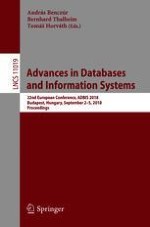This book constitutes the proceedings of the 22nd European Conference on Advances in Databases and Information Systems, ADBIS 2018, held in Budapest, Hungary, in September 2018.
The 17 regular papers presented together with two invited papers were carefully selected and reviewed from numerous submissions. The papers are organized in topical sections such as information extraction and integration; data mining and knowledge discovery; indexing, query processing and optimization; data quality and data cleansing; distributed data platforms, including cloud data systems, key-value stores, and big data systems; and streaming data analysis; web, XML and semi-structured databases.
